PROTECT YOUR DNA WITH QUANTUM TECHNOLOGY
Orgo-Life the new way to the future Advertising by AdpathwayIf you’re looking for a flowering shrub to fill in a large gap in your garden or want to install a new hedge, check out spirea. This genus of flowering shrubs adds interest thanks to its textured foliage and clusters of tiny flowers that become abuzz with pollinators. Many spirea varieties also undergo a beautiful color change during autumn, providing interest for the majority of the year.
You can find hundreds of different spirea varieties with varied growth habits, heights, and flower shapes. There are even multiple native species that add height and texture to native landscaping projects.
Not only are spirea beautiful, but they’re also relatively carefree and easy to maintain. Let’s dig into all you need to know about planting and caring for these shrubs.
Spirea Overview
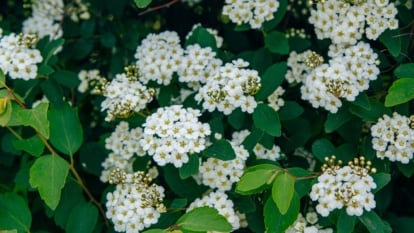
|
Plant Type Deciduous woody shrub Family Rosaceae Genus Spiraea Species variable |
Native Area North America and Asia Exposure Full sun Height 1-8 feet Watering Requirements Moderate |
Pests & Diseases Powdery mildew, fire blight, root rot, aphids Maintenance Low Soil Type Well-draining Hardiness Zone 3-9 |
What Is Spirea?
The Spiraea genus contains nearly 100 species of deciduous, flowering shrubs. Their attractive foliage and clusters of small flowers make them popular ornamental plants for hedgerows and stand-alone shrubs.
You may also hear people refer to spirea plants as meadowsweet or steeplebushes.
Characteristics
 They have gorgeous flowers and shed their leaves in the fall.
They have gorgeous flowers and shed their leaves in the fall.Although the numerous species and cultivars have distinctive growing habits and environmental preferences, all types of spirea share a few characteristics. The plants are woody and deciduous, meaning they retain their shape throughout the winter but shed their leaves in the fall. Some varieties produce their flowers in the late spring, while others bloom in the summer.
Spirea plants also display diverse bloom styles. Some types of spirea form flat umbels of tiny flowers, others arrange their flowers in long spikes, and others display tiny round clusters of flowers. Flowers are typically white or pink, but you can also find varieties with red and purple blooms.
Spirea plants grow quickly; healthy plants can easily add a foot of new growth each year. The max size depends on the species and variety, as well as the environment. Some species grow only a few feet tall, while others can reach up to eight feet.
Native Range
 Most of the genus is native to Asia.
Most of the genus is native to Asia.All spirea species are native to the Northern Hemisphere. The majority of species are native to temperate parts of Asia, mainly China, but a handful of species call North America home. Some of these North American natives thrive on the East Coast, and others like the environments of the Pacific Northwest.
Although there are numerous species of native spireas, many of the varieties sold in garden centers and nurseries are native to Asia. Some of these species have naturalized in the United States, meaning they’re often found growing in seemingly wild places even though they weren’t always here.
Planting
 Potted plants are usually the easiest to find and plant.
Potted plants are usually the easiest to find and plant.Transplanting a young shrub is the easiest way to add a new spirea plant to your garden. Potted plants are the most common option, but you can also find dormant, bare-root shrubs.
The early spring and late fall are the best times to transplant these spirea, as they provide them with a chance to settle into their new homes without the stress of extreme heat or cold. This cool period allows the plants to establish their roots before hot weather arrives.
Once you determine when you’d like to plant your shrub, pick a suitable location. All types of spirea like well-draining soil, but the ideal light conditions vary by species. Research the type you’re growing to ensure you’re providing the correct amount of light.
When it’s time to plant, dig a hole that’s as deep as the plant’s root system and a few inches wider. Soak the roots of bare-root plants for a couple of hours before planting. Place the root ball or bare roots in the hole, then cover the remaining empty space with soil. Water deeply after planting.
If you’re planting multiple spirea plants for a hedge or border, pay close attention to the type you’re growing. Each variety has ideal spacing requirements. You can plant smaller varieties two or three feet apart, but larger plants prefer five or six feet of space.
Continue to water regularly in the first few weeks after transplanting. If you plant in the fall, you can decrease the amount you water after two weeks. Continue to water spring-planted spirea weekly to help the plants transition to summer.
How to Grow Spirea
These are easy-to-grow shrubs that grow well without much care. Choosing the correct growing environment will help your new plant thrive.
Light
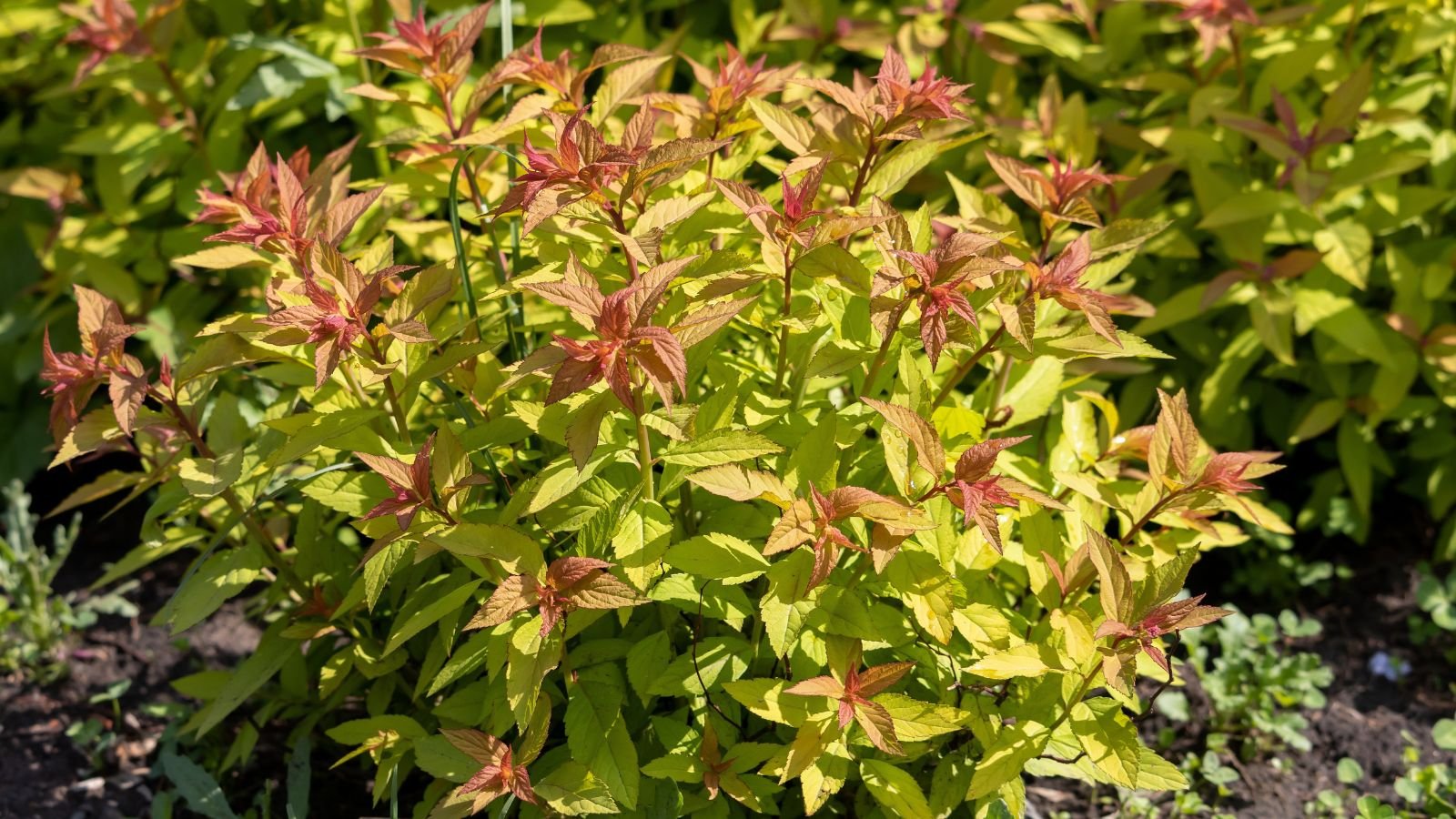 More sunlight is ideal for flower production.
More sunlight is ideal for flower production.Most types of spirea grow best in full sun or partial shade. Full sun encourages more flowers, so choose a location that receives at least eight hours of sun if you’re looking forward to lots of blooms.
An area with afternoon light is also suitable, especially if you live in a warm climate. Just make sure the plants receive four hours of direct light each day. You can also plant these shrubs in a location with light, dappled shade.
Water
 They can go a while without water, but appreciate deep waterings during dry periods.
They can go a while without water, but appreciate deep waterings during dry periods.Mature spirea plants are relatively drought-tolerant and only require water during summer dry spells. If you go more than a week without water, deeply water these shrubs to keep them healthy.
Recently transplanted spirea requires more attention and care. Since the plants haven’t developed root systems that can reach water deep underground, they require more frequent irrigation. Water slowly and deeply once every three to five days, or when the soil feels dry.
Avoid overhead irrigation, and water near the base of the plants. You can use a hose or watering can to slowly add water to the soil surrounding the plants, or install a drip irrigation system.
Soil
 They prefer a pH between 6.0 and 7.0.
They prefer a pH between 6.0 and 7.0.Spirea plants grow best in well-draining soil that remains moderately moist. Soil high in organic matter is ideal, but these shrubs can grow well in other soil types as long as they don’t hold excessive moisture. It’s a good idea to check the pH before planting, since these shrubs grow best in soil with a pH between 6.0 and 7.0.
Temperature and Humidity
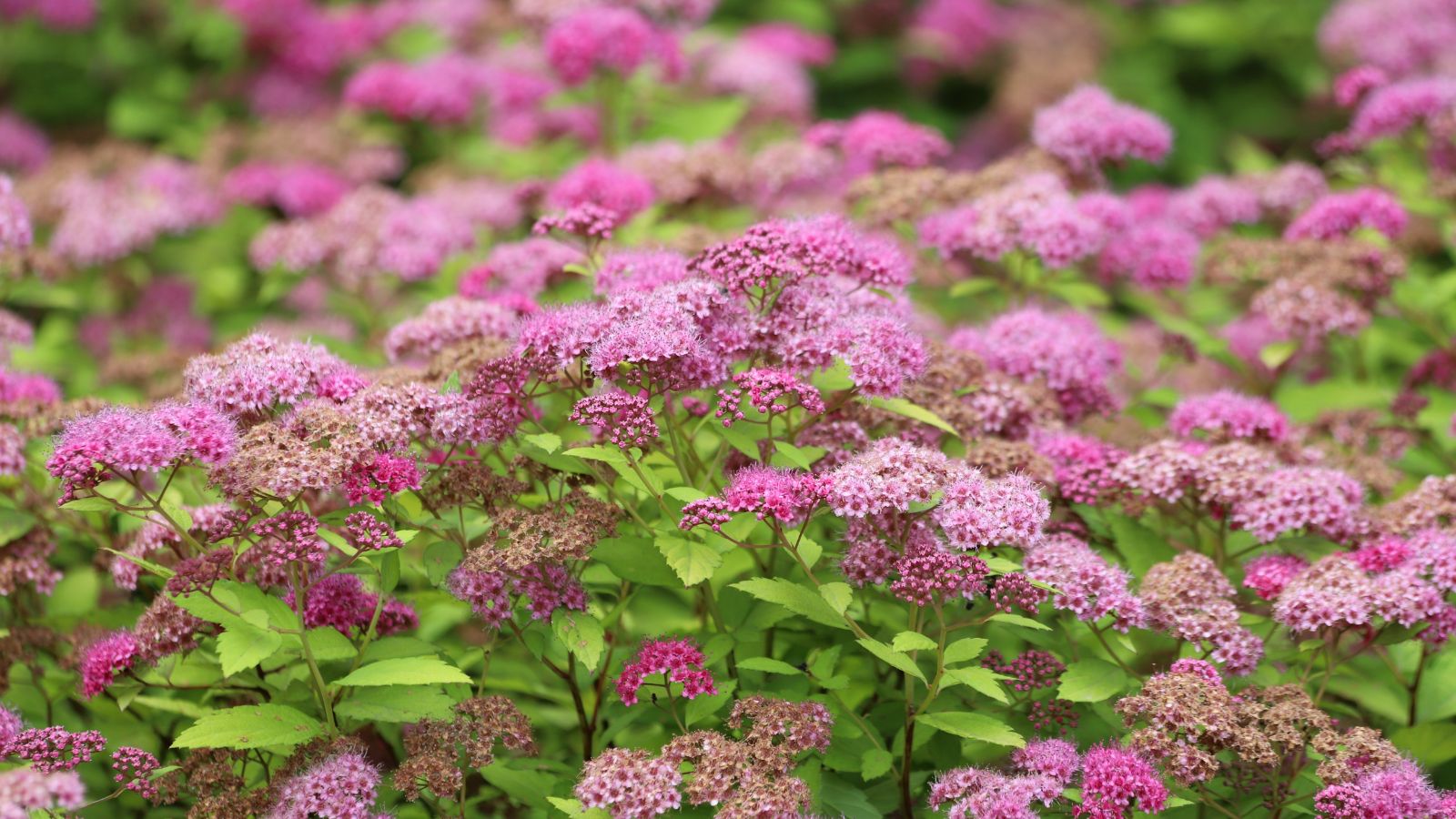 They’re hardy across a wide range of zones.
They’re hardy across a wide range of zones.You can find spirea species that are hardy in zones 3 through 9. That means gardeners in much of the United States can grow these perennials with ease. Note that some spirea species can tolerate cold and others high heat, so choose a variety that’s well-suited to your growing area.
If you live in zone 3, pay careful attention to cold hardiness. Many spirea species are only hardy to zone 4, so ensure that you choose a variety that can tolerate your cold winter temperatures. Mulching the base of the plants will help insulate the roots and further protect them from chilly weather.
These plants can tolerate a range of humidity levels, so don’t worry about the air moisture levels.
Fertilizing
 Opt for a slow-release, balanced fertilizer blend.
Opt for a slow-release, balanced fertilizer blend.Spirea plants don’t require a lot of fertilizer to remain healthy. Applying a balanced, low-dose, slow-release fertilizer in the spring will supply the plants with all the nutrients they need. You can choose a blended organic fertilizer or apply a nutrient-rich compost.
Avoid applying too much fertilizer since this can cause more issues than under-fertilizing.
Maintenance
 Pruning encourages new growth and helps shape the plant.
Pruning encourages new growth and helps shape the plant.Spirea will continue living without any maintenance, but pruning the shrubs will keep them tidy and encourage them to produce new growth and flowers. The best time to prune these shrubs depends on the type you’re growing.
Spring-blooming spirea flowers on old wood. Therefore, it’s best to prune these plants right after they finish flowering. Pruning early gives the plant time to establish new growth before winter arrives.
Summer-blooming varieties flower on new wood that’s produced earlier in the growing season. Pruning in late fall or early spring is ideal since it encourages the plant to produce new growth and flowers.
Always use sharp and sanitized shears when you prune. Start by removing any dead or damaged wood, then remove crossing or crowded branches.
Propagation
There are a few ways you can propagate existing spirea shrubs to form new plants. Taking softwood cuttings, layering branches, and dividing suckers are the three most reliable methods.
Softwood Cuttings
 Late spring or early summer are the best times to propagate by softwood cuttings.
Late spring or early summer are the best times to propagate by softwood cuttings.Taking and rooting stem cuttings in the late spring or early summer is one of the easiest ways to propagate new spirea plants. Start by looking for healthy softwood; these sections of the plant grew this year and are easy to bend. Take a cutting that’s at least four inches long with at least one leaf node.
If you took a long cutting, trim it so it’s four to eight inches long, then strip off the lower leaves. Dip the bottom end of the cutting in a rooting hormone, and place it in a container filled with well-draining and moist media. Perlite, coco coir, and vermiculite are all suitable options.
Keep the cuttings in a humid area, or cover them with a plastic bin to trap in moisture. Water the media to keep it moist and place the cuttings in a warm area out of direct light. They should form roots within a few weeks, and then you can transplant them.
Layering
 Bend and bury low-lying stems to encourage them to root.
Bend and bury low-lying stems to encourage them to root.Another propagation method involves bending low-lying stems so they come into contact with the soil. The portion of the plant that’s touching the soil will eventually form adventitious roots. Once the stem is rooted, you can cut it from the plant and transplant it to a new location.
Dividing Suckers
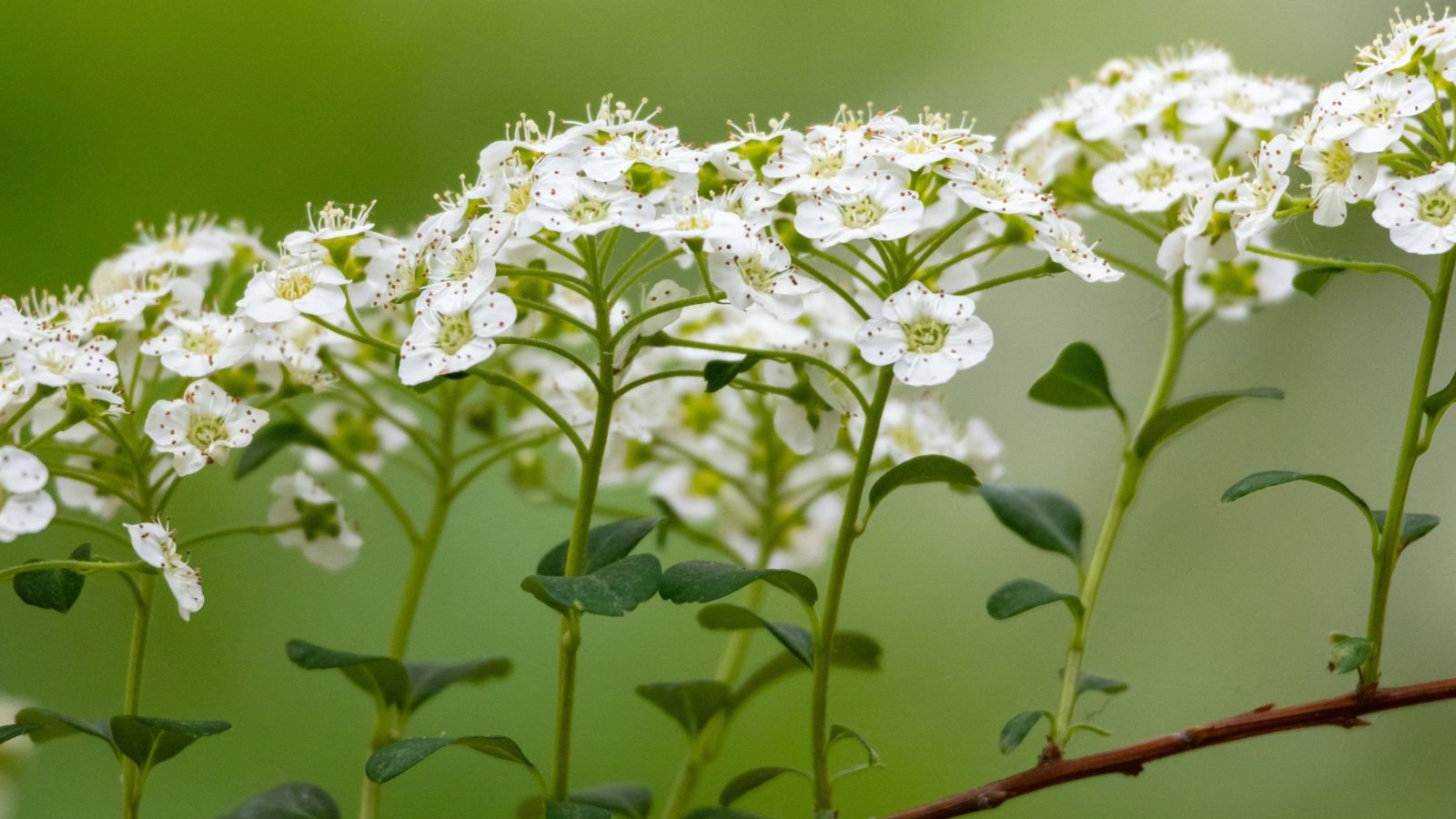 Suckers are best divided to prevent them from sucking energy away from the main plant.
Suckers are best divided to prevent them from sucking energy away from the main plant.Sometimes, these woody perennials forms suckers close to the base of the plant. While these suckers are usually pruned since they take nutrients away from the main plant, they’re also candidates for propagation.
Insert a shovel between the main plant and the sucker while lifting up towards the sucker. You may need to cut portions of the main root system to remove the sucker from the rest of the plant. Once it’s separated, you can replant it in a new location.
Popular Varieties
There are nearly 100 species of spirea and even more varieties. Here are a few of the most popular options.
Baby’s Breath Spirea
 This is one of the first varieties to bloom in the spring.
This is one of the first varieties to bloom in the spring.Spiraea thunbergii is also known as “breath of spring” spirea. It’s native to Asia and is one of the first types of spirea to bloom in the spring. The leafless stems become covered in tiny white flowers, and the green leaves emerge after the flowers.
Birchleaf Spirea
 They are low-growing, with foliage that resembles a birch tree.
They are low-growing, with foliage that resembles a birch tree.Birchleaf spirea (Spiraea betulifolia) is an Asian species that grows only two to three feet tall. It has rounded leaves that resemble birch foliage and produces rounded clusters of small white or light pink flowers.
Japanese Spirea
 It is considered invasive in some areas.
It is considered invasive in some areas.Perhaps the most commonly-planted spirea, Spiraea japonica is native to parts of Asia. Plant breeders have created many different cultivars of this species with varied heights, flower colors, and foliage. While this species is easy to find in garden centers, be aware that it’s considered an invasive species in many locations.
White Meadowsweet
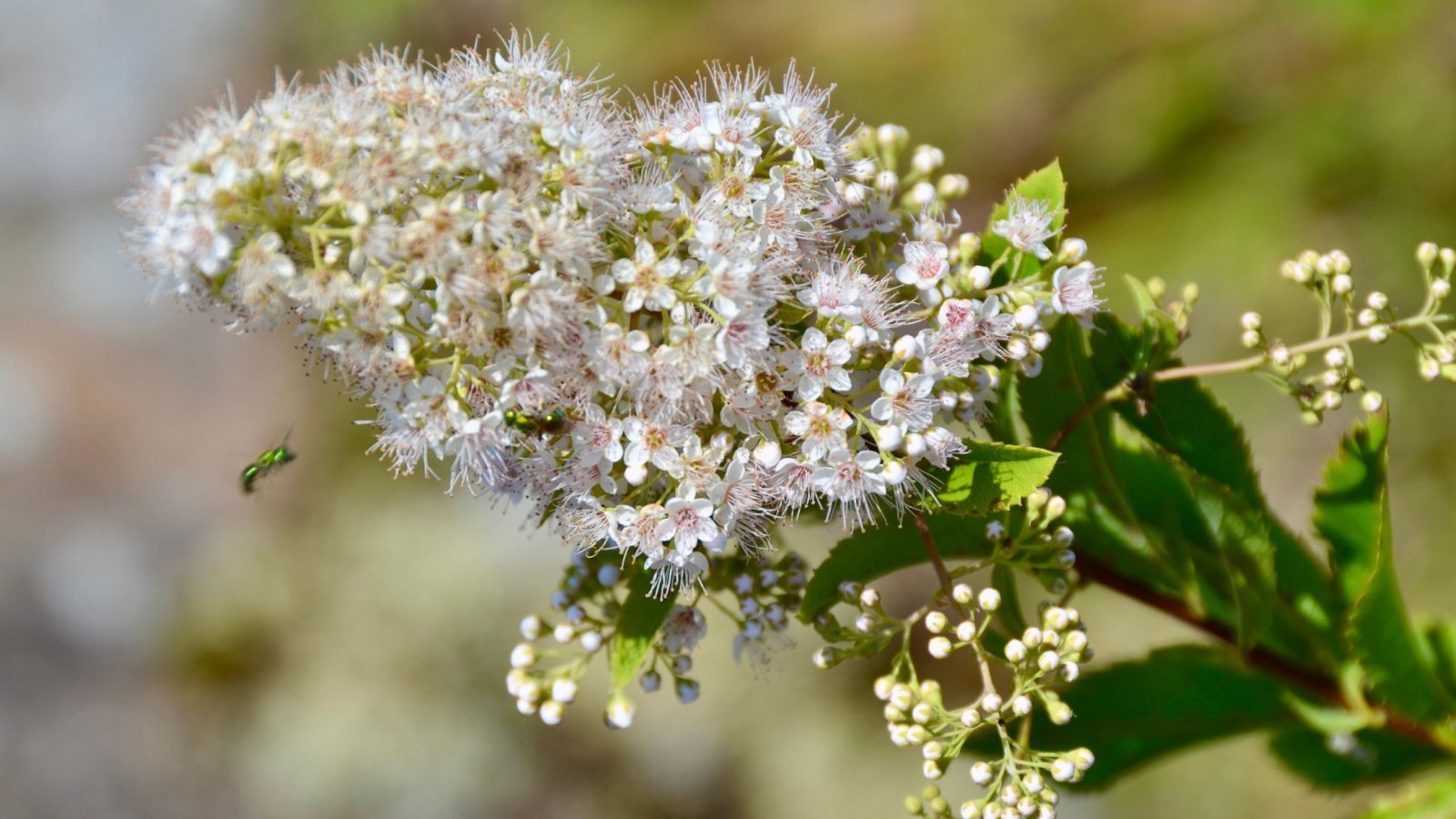 They produce tiny pink or white flowers.
They produce tiny pink or white flowers.Spiraea alba is native to parts of the eastern and midwestern United States. The tiny white or light pink flowers are arranged in elongated clusters that form on the ends of plant stems.
Common Issues
These flowering shrubs are fairly problem-free, especially when compared to flowering shrubs like roses. They can still experience problems, so keep an eye out for the following.
Powdery Mildew
 Prune off any infected portions, and sanitize your tools thoroughly.
Prune off any infected portions, and sanitize your tools thoroughly. This fungus coats leaves in a white, powdery layer. Powdery mildew won’t necessarily kill plants, but it will limit photosynthesis and slow plant growth. Pruning off infected portions of the plant is often the best way to control the spread.
You can help prevent infection by planting at appropriate spacing and pruning to encourage good airflow. Avoiding overhead watering will also keep the disease away. If you know that powdery mildew is often a problem, choose resistant varieties.
Fire Blight
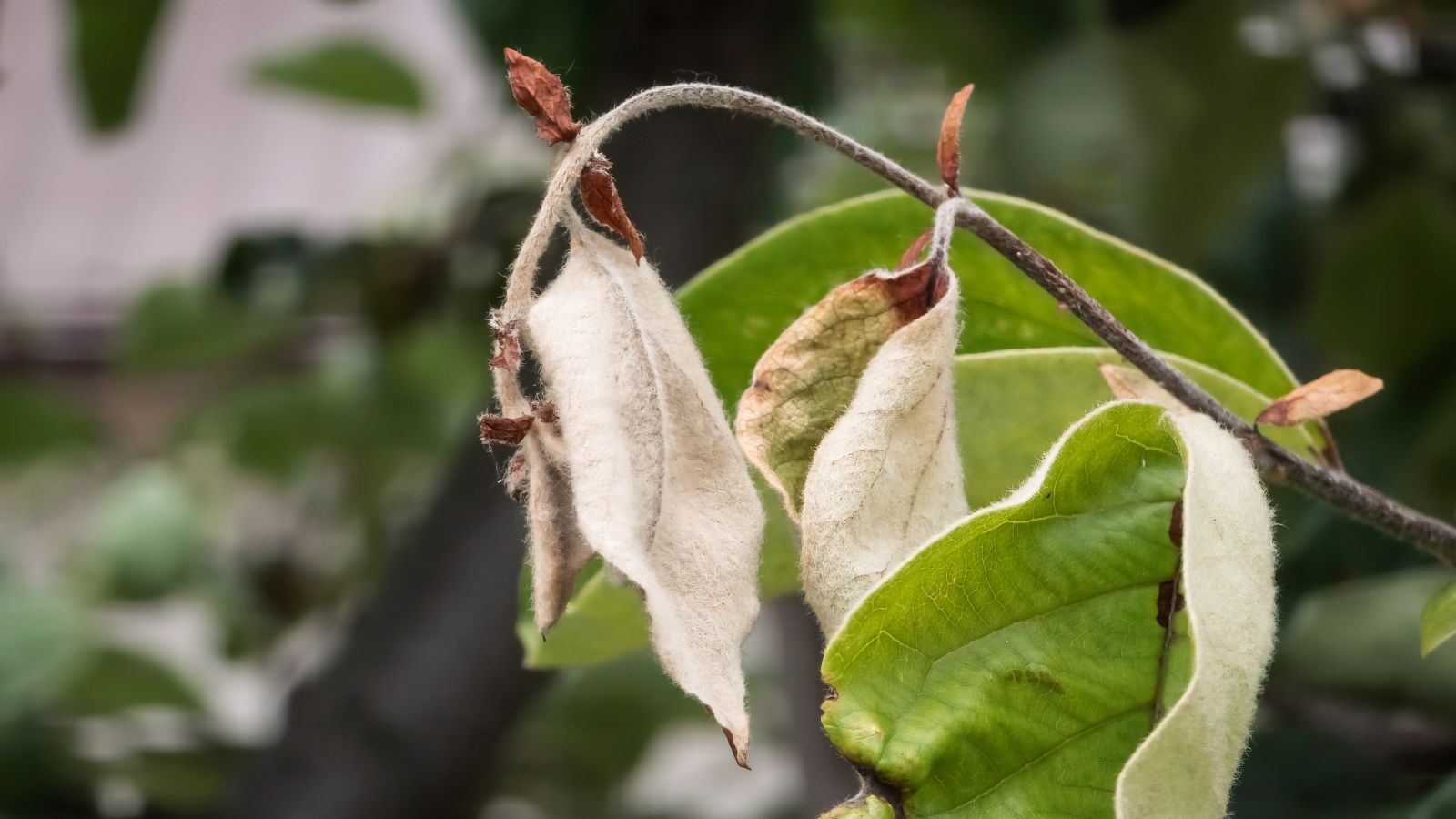 Resistant varieties are the best means of prevention.
Resistant varieties are the best means of prevention.Fire blight is a bacterial disease that most frequently infects pear and apple trees, but it can also impact spirea. The disease causes flowers to become discolored and shriveled, and young shoots die back and appear burnt. Eventually, the entire plant may die.
Planting resistant varieties is the best way to prevent fire blight from infecting your plants. If you notice an infection, prune out and dispose of the diseased portions.
Root Rot
 Be sure to avoid soggy, waterlogged soils.
Be sure to avoid soggy, waterlogged soils.Phytophthora or Pythium are problems in areas where spireas are grown in soggy soils. If you live in an area that tends to be boggy, amend your soil with some grit or agricultural sand to promote better drainage.
Plants that take on the fungi associated with these conditions experience root rot. The first signs of either are wilting leaves and mushy stems at the base of the plant. Stop watering at first, then check the roots to ensure there is still healthy tissue present. Severely damaged plants should be removed from the garden and thrown away.
Aphids
 They are unlikely to cause a major problem, but can be removed with insecticidal soap or neem oil.
They are unlikely to cause a major problem, but can be removed with insecticidal soap or neem oil.Aphids impact just about every type of plant, including spirea. While natural predators often keep these aphid numbers low, they can sometimes spiral out of control. Aphids are unlikely to kill spirea plants, but they can weaken them as they drink the plant’s sap.
You can remove aphids by spraying them with insecticidal soap or neem oil. Repeat applications may be necessary, so check your plants for the pests every few days after you first spot them.
Frequently Asked Questions
It depends on the species. Some of these plants are native to the United States and are not invasive. Others, like Japanese spirea, outcompete native vegetation and are considered invasive.
Newly-planted shrubs require moist soil until they’re well established. Older plants can tolerate moderately dry soil, but they grow best if they receive a deep watering about once a week.
Unfortunately not. Deer and rabbits both like to munch on these stems and leaves, so it’s not the best option if you live in an area with heavy wildlife pressure.


 1 week ago
12
1 week ago
12





















 English (US) ·
English (US) ·  French (CA) ·
French (CA) ·